Dunbar
Dunbar (/dʌnˈbɑːr/ (![]()
| Dunbar | |
|---|---|
Tolbooth and mercat cross, Dunbar High Street | |
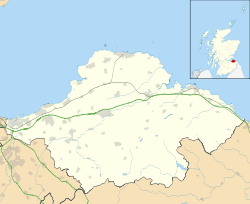 Dunbar  Dunbar Location within Scotland | |
| Area | 3.01 km2 (1.16 sq mi) [2] |
| Population | 8,486 [3] (2011 census) |
| • Density | 2,819/km2 (7,300/sq mi) |
| OS grid reference | NT678789 |
| • Edinburgh | 26 mi (42 km) |
| • London | 325 mi (523 km) |
| Council area | |
| Lieutenancy area | |
| Country | Scotland |
| Sovereign state | United Kingdom |
| Post town | DUNBAR |
| Postcode district | EH42 |
| Dialling code | 01368 |
| Police | Scotland |
| Fire | Scottish |
| Ambulance | Scottish |
| UK Parliament | |
| Scottish Parliament | |
Dunbar is a former royal burgh, and gave its name to an ecclesiastical and civil parish. The parish extends around 7 1⁄2 mi (12 km) east to west and is 3 1⁄2 mi (6 km) deep at its greatest extent, or 11 1⁄4 sq mi (29 km2), and contains the villages of West Barns, Belhaven, East Barns (abandoned) and several hamlets and farms.
Its strategic location gave rise to a history full of incident and strife; but Dunbar has become a dormitory town popular with workers in nearby Edinburgh. Until the 1960s, the population of the town was little more than 3,500. In 2010 the population was 8,486,[4] and there are many active and planned housing developments ongoing. There are primary schools, a secondary school and a private school in the town.
The town is served by Dunbar railway station with links to Edinburgh and the rest of Scotland, as well as London and stations along the north-east corridor.
Dunbar is home to the Dunbar Lifeboat Station, the second-oldest RNLI station in Scotland.
Dunbar is the birthplace of the explorer, naturalist and influential conservationist John Muir.[5][6] The house in which Muir was born is located on the High Street, and has been converted into a museum. There is also a commemorative statue beside the town clock, and John Muir Country Park is located to the north-west of the town. The eastern section of the John Muir Way coastal path starts from the harbour. One of the two campuses to Dunbar Primary School: John Muir Campus, is named in his honour.
On the last full weekend in September, Dunbar holds an annual weekend-long, traditional music festival sponsored by various local companies.
History
Etymology
In its present form, the name Dunbar is derived from its Gaelic equivalent (modern Scottish Gaelic: Dùn Barra), meaning "summit fort". That itself is probably a Gaelicisation of the Cumbric form din-bar, with the same meaning. This form seems to be attested as Dynbaer the seventh-century Vita Sancti Wilfredi.[7]
Early history
To the north of the present High Street an area of open ground called Castle Park preserves almost exactly the hidden perimeter of an Iron Age promontory fort.[8] The early settlement was a principal centre of the people known to the Romans as Votadini and it may have grown in importance when the great hillfort of Traprain Law was abandoned at the end of the 5th century AD. Dunbar was subsumed into Anglian Northumbria as that kingdom expanded in the 6th century and is believed to be synonymous with the Dynbaer of Eddius around 680, the first time that it appears in the written record. The influential Northumbrian monk and scholar St Cuthbert, born around 630, was probably from around Dunbar. While still a boy, and employed as a shepherd, one night he had a vision of the soul of Saint Aidan being carried to heaven by angels and thereupon went to the monastery of Old Melrose and became a monk.
It was then a king's vill and prison to Bishop Wilfrid. As a royal holding of the kings of Northumbria, the economy centred on the collecting of food renders and the administration of the northern (now Scottish) portion of that kingdom. It was the base of a senior royal official, a reeve (later sheriff), and, perhaps, in the 7th century a dynasty of ealdormen or sub-kings who held northern Northumbria against Pictish encroachment.
Scottish conquest
Danish and Norse attacks on southern Northumbria caused its power to falter and the northern portion became equally open to annexation by Scotland. Dunbar was burnt by Kenneth MacAlpin in the 9th century. Scottish control was consolidated in the next century and when Lothian was ceded to Malcolm II after the battle of Carham in 1018, Dunbar was finally an acknowledged part of Scotland.
Throughout these turbulent centuries Dunbar’s status must have been preserved because it next features as part of a major land grant and settlement by Malcolm III in favour of the exiled earl Gospatric of Northumbria (to whom he may have been full cousin) during 1072. Malcolm needed to fill a power vacuum on his south-eastern flank; Gospatric required a base from which to plot the resumption of his Northumbrian holding. The grant included Dunbar and, it can be deduced, an extensive swath of East Lothian and Berwickshire or Merse (hence March). Gospatric founded the family of Dunbar. The head of the House of Dunbar filled the position of Earls of Dunbar and March until the 15th century.
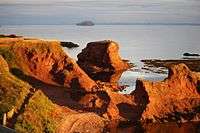
Later history


The town became successively a baronial burgh and royal burgh (1370) and grew slowly under the shadow of the great Castle of the Earls. Scotland and England contended often for control of the castle and the town. The former was "impregnable" and withstood many sieges; the latter was burnt, frequently. The castle had been slighted (deliberately ruined) in 1568 but the town flourished as an agricultural centre and fishing port despite tempestuous times in the seventeenth and early-eighteenth centuries. Major battles were fought nearby in 1296 and 1650. The second Battle of Dunbar (1650) was fought during the Wars of the Three Kingdoms between a Scottish Covenanter army and English Parliamentarians led by Oliver Cromwell. The Scots were routed, leading to the overthrow of the monarchy and the occupation of Scotland.
A permanent military presence was established in the town with the completion of Castle Park Barracks in 1855.[11]
Dunbar gained a reputation as a seaside holiday and golfing resort in the nineteenth century, the "bright and breezy burgh" famous for its "bracing air".
Since 1983, the town has held the first outdoor Pipe Band competition of the season in Scotland. The competition, now held at Hallhill Sports Centre on the second Saturday in May, attracts in the region of 70–80 entries from bands across Scotland and over 2,000 visitors for the day. The local band, Dunbar Royal British Legion Pipe Band, has competed with success over the years.
On Saturday 3 January 1987, a devastating fire destroyed much of the town's historic parish church. The church, as it was before the fire, was opened in 1821 and contained a monument to the Earl of Dunbar (1611) which was said to be unequalled throughout Scotland for its Italian craftsmanship in marble. Though the fire practically destroyed the monument and left only the outer walls remaining, the church has since been rebuilt with a modern interior.
Notable residents
- Joan Beaufort, Queen of Scots, wife of King James I of Scotland, who served as the Regent of Scotland in the immediate aftermath of his death and during the minority of her son James II of Scotland, before being engulfed in a power struggle with members of the nobility. In desperation she took refuge in Dunbar Castle where she was subsequently besieged by her opponents, in which place and circumstances she died in the year 1445[12]
- Alexander Stewart, Duke of Albany, second son of King James II of Scotland and Mary of Guelders, was Duke of Albany, Earl of March, Lord of Annandale and Isle of Man and the Warden of the Marches, which altogether gave him an impressive power base in the east and west borders, centred on Dunbar Castle which he owned and lived in. He attempted to seize control of Scotland from his brother King James III of Scotland, but was ultimately unsuccessful.[13]
- John Stewart, Duke of Albany, de facto ruler of Scotland and important soldier, diplomat and politician in a Scottish and continental European context, was the only son of the above Duke of Albany, and managed where his father had failed and became Regent of Scotland, while he also became Count of Auvergne and Lauraguais in France and, lastly, inherited from his father the position of Earl of March, which allowed him to likewise use Dunbar Castle as his centre of power in Scotland.[14][15]
- Alexander Dow, influential Orientalist, author and British East India Company army officer and resident and educated in Dunbar for part of his boyhood.
- William Alexander Bain pharmacologist
- Dr James Wyllie Gregor FRSE botanist, born in Dunbar
- Sir Anthony Home, VC KCB, British soldier who was notable as a recipient of the Victoria Cross and the eventual achievement of the rank of Surgeon-General of the British Armed Forces, born and bred in Dunbar from a local family.
- John Muir, important conservationist, geologist, environmental philosopher and pacifist; one of the founders of the United States system of National Parks and Sierra Club
- General Sir Reginald Wingate, 1st Baronet, GCB, GCVO, GBE, KCMG, DSO, TD, army officer and colonial governor, 'the maker of the Anglo-Egyptian Sudan', Governor-General of the Sudan (1899–1916), British High Commissioner in Egypt (1917–1919), commander of military operations in the Hedjaz (1916–1919), for many years the senior general of the British army, long-time resident in Dunbar[16]
- Robert Wilson (engineer), one of the inventors of the ship's propeller, born and bred in Dunbar from a local family
- Black Agnes, Countess of Dunbar and heroine of local folklore[17]
- James Hepburn, 4th Earl of Bothwell, notorious third and last husband of Mary, Queen of Scots, and owner of Dunbar Castle
- Hugh Trevor-Roper, renowned English historian who boarded at Belhaven Hill School
- Walter Runciman, 1st Baron Runciman, major shipowner and maverick Liberal politician, born in Dunbar to parents from Dunbar[18]
- Saint Wilfrid, 7th to early 8th century English bishop and saint was imprisoned for a time in Dunbar[19]
- Saint Cuthbert, early saint and evangelist of the Northumbrian church, Bishop of Lindisfarne,[20] at a time when Northumbria was a leader in promoting and spreading the message of Christianity in a British and wider European context[21] and, he was, according to some authors, born in and initially brought up in Dunbar to a local noble family, before being fostered in the Melrose area with a related or allied family as per the traditions of his class and time.[22]
- Maria Lyle, Para-sprinter, won medals at both the Commonwealth and Olympic Games.
Notable buildings
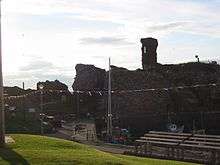
.jpg)
- Chapel tower (with doocot conversion) of the Trinitarian Priory, Friarscroft, west of the town. Founded c. 1240 by Christiana de Brus, Countess of Dunbar.
- Dunbar Castle, possibly from the 14th century, rebuilt and remodelled c. 1490 and c. 1520. Largely ruined with the aid of gunpowder (deliberately by Act of Parliament) in 1567 and with the whole north end removed with the aid of explosives (detonated using a specially-invented electrical system) for the new Victoria Harbour 1842–44.
- Parish church (see above) by James Gillespie Graham 1818–21 in local red sandstone from Bourhouse quarry[23]
- Parish Church Hall (1910), located behind the post office off the High Street, contains stained glass removed from St Giles' Cathedral, Edinburgh, redundant there on the creation of the Thistle Chapel.[23]
- Abbey Free Church (1850) by Thomas Hamilton (architect).
- St Anne's Episcopal Church (1889) by Robert Rowand Anderson.
- Dunbar Methodist Church is the oldest Methodist Church in Scotland, having been erected in 1764. Both John Wesley and Charles Wesley were trustees of the Society in Dunbar and John preached at the Methodist Church on 21 occasions.[24]
- The Town House (Tolbooth), High Street, (c.1550).
- Mercat Cross (c.1911) created from medieval fragments to replace lost original sited opposite West Port. Now beside Town House.
- Lauderdale House (1790–92), designed by Robert Adam and executed by his brother John after Robert's death; built round the carcass of Dunbar House (c1730).
- Railway station (1845) but altered.
- Cromwell Harbour, very old fishing harbour which dates to 1600s
- Ordance Survey Tidal Gauge - Beneath the Castle Rock at Victoria Harbour is a small castellated building, now the Harbourmaster's office, but originally built in 1913 by the Ordnance Survey and used as part of a network that was used to establish the 'Mean Sea Level' that is used as the reference benchmark for all heights 'above sea level' in the UK.
- Dunbar Battery (1781) was built to protect the town from privateers in the 18th Century and restored in 2017 by Dunbar Harbour Trust with improvements made to access and a new outdoor amphitheatre sensitively inserted within the defensive walls. The Dunbar Battery also features "Sea Cubes", a public artwork by Scottish artist Donald Urquhart. The project won the Architects' Journal Architecture Awards 2017 for the Best Budget Project of the Year and was Commended in the Scottish Civic Trust My Places Awards 2018.
Archaeology
During 2003, archaeological excavations at Oxwell Mains (Lafarge Cement Works) near Dunbar revealed the site of a Mesolithic house believed to be from around the 9th millennium BC. The site suggests a domed building. Although considered extremely rare and a site of national importance this site is in the middle of an area planned for quarrying.
An archaeological excavation undertaken by Headland Archaeology on a site previously occupied by the Captain's Cabin (a local landmark) within the area of Castle Park identified a sequence of archaeological features reflecting around 2,000 years of human activity.[25] The earliest feature was a large ditch which may have formed part of the defences around a promontory fort previously identified during earlier excavations near the coast at Castle Park. The scale of the ditches indicated an impressive monument. A radiocarbon date of between 50 BC and AD 70 was obtained from charcoal recovered from its infill.
Much later a rectangular building was built over the top of the infilled ditch. Large quantities of burnt grain were recovered indicating that the building was a grain store that had been destroyed by fire. It was established that this was part of the Anglian settlement that had also been identified during earlier excavations.
Between the 9th and 11th centuries the area was used as a cemetery. Archeologists excavated 76 articulated skeletons and the disarticulated remains of a further 51 individuals were recovered. The articulated skeletons were all buried in the standard Christian fashion. A small number of the skeletons were in long cists but the majority were simple shroud burials.
A dump or midden above the cemetery contained many elephant ivory off-cuts dating to the 18th or 19th centuries.
Climate
As with most of the British Isles, Dunbar has an oceanic climate (Köppen: Cfb) with cool summers and mild winters. It is one of the sunniest and driest places in Scotland, with around 1,450 hours of sunshine and 600 mm (24 in) of rainfall annually. Temperature extremes range from 31.0 °C (87.8 °F) in August 1990[26] to −12.0 °C (10.4 °F) in January 1982.[27]
| Climate data for Dunbar (20 m or 66 ft asl, averages 1981–2010) | |||||||||||||
|---|---|---|---|---|---|---|---|---|---|---|---|---|---|
| Month | Jan | Feb | Mar | Apr | May | Jun | Jul | Aug | Sep | Oct | Nov | Dec | Year |
| Average high °C (°F) | 7.1 (44.8) |
7.4 (45.3) |
9.2 (48.6) |
11.0 (51.8) |
13.7 (56.7) |
16.7 (62.1) |
18.8 (65.8) |
18.8 (65.8) |
16.5 (61.7) |
13.2 (55.8) |
9.7 (49.5) |
7.3 (45.1) |
12.5 (54.4) |
| Average low °C (°F) | 1.9 (35.4) |
2.0 (35.6) |
3.1 (37.6) |
4.5 (40.1) |
6.7 (44.1) |
9.6 (49.3) |
11.4 (52.5) |
11.5 (52.7) |
9.9 (49.8) |
7.3 (45.1) |
4.3 (39.7) |
2.1 (35.8) |
6.2 (43.1) |
| Average rainfall mm (inches) | 49.0 (1.93) |
34.4 (1.35) |
42.5 (1.67) |
36.1 (1.42) |
44.7 (1.76) |
56.9 (2.24) |
55.9 (2.20) |
55.0 (2.17) |
57.4 (2.26) |
62.5 (2.46) |
54.5 (2.15) |
54.6 (2.15) |
603.5 (23.76) |
| Average rainy days (≥ 1 mm) | 10.5 | 8.0 | 9.0 | 8.0 | 9.2 | 9.9 | 9.4 | 9.6 | 9.0 | 11.0 | 10.4 | 11.0 | 115 |
| Mean monthly sunshine hours | 58.0 | 77.6 | 114.9 | 146.6 | 192.4 | 171.3 | 179.2 | 163.2 | 128.7 | 100.0 | 71.3 | 48.1 | 1,451.3 |
| Source: Met Office[28] | |||||||||||||
Environment
Due to its geographical location, Dunbar receives less rain and more hours of direct sunshine per year than most places in Scotland.[28] The town has begun to be referred to by locals as 'Sunny Dunny', after a local radio host popularised the term.
Dunbar has two promenades (forming part of the John Muir Way). These provide an ideal viewpoint to see Dunbar's geological features: including volcanic deposits and dykes; seen from a high vantage point on the western, clifftop promenade, which passes the town's Public and Winterfield parks. Looking down onto a raised shore platform, and the raised beaches, further along the coast, one can get an appreciation of the glacial-isostatic uplift that has occurred in this part of Scotland.
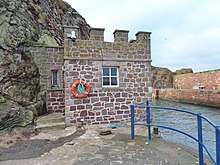
Economy
The town has an Asda supermarket and a range of local shops. The store is accompanied by a drive-thru McDonald's built in late-2015 (also the first of its kind in East Lothian), a restaurant owned by Marston's named the Pine Marten, a hotel also owned by Marston's and a garden centre.[29][30]
Agriculture remains important, but fishing has declined. Its main manufacturers are cement at Tarmac's Dunbar Cement Plant at Oxwell Mains (the only integrated cement plant in Scotland) and the Scottish Ales of Belhaven Brewery. Another large local employer is Torness Nuclear Power Station.
More recently Dunbar has become a base for many adventure sports with a local surf school and wakeboarding park. Alongside, activities including coasteering, stand up paddle boarding, a ropes course and zip lining are also increasingly popular.
Twin towns
Dunbar is twinned with Lignières, in France and Martinez, California, United States.
Sport
.jpg)
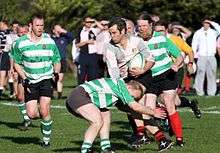

Football
Dunbar is home to the football club Dunbar United, who play at New Countess Park and compete in the East of Scotland League Premier Division.
Dunbar is also home to the Dunbar United Colts Football Club,[31] who play their home matches at Hallhill Sports Centre. The club is open to boys and girls and has around 400 members from 4 years old who play at the Soccer School sessions, right up to adults (Dunbar Athletic) who play in the amateur league. The Colts Festival takes place on the second Saturday of Dunbar Civic Week in June of each year. Football has been enjoyed by Dunbar children as long ago as the 1920s. During the 1960s the first youth team was formed as Belhaven Boys Club. In 1992 the club was renamed Dunbar United Colts Football Club. In September 2001 The Colts moved to their new home at the newly built Hallhill Healthy Living Centre, now known as Hallhill Sports Centre. The Colts are affiliated to the Scottish Youth Football Association and have received the SYFA Community Award.
Golf
Dunbar Golf Club: Laid out in 1857 and redesigned by Old Tom Morris around 1894, Dunbar East Links is situated on the estuary of the Firth of Forth. It is used as an Open Championship Qualifying Venue when the Open is played at Muirfield and all of the major Scottish Championships have been played here, The Scottish Amateur, Scottish Professional Championships, and Scottish Boys’ Championship. The British Ladies and the Ladies Home Internationals have also enjoyed Dunbar as a venue. Dunbar is also home to Winterfield Golf Club.
Rugby
Dunbar is also home to Dunbar RFC. They play their home games at Hallhill Sports Centre and operate a 1st XV, 2nd XV and various school teams. The 1st XV play in the East Region League Division 2.
Basketball
Dunbar Grammar School hosts basketball training for many school and club squads. School teams often participate in the Scottish Cup competition for their appropriate level. The school also hosts training for the club Dunbar Dragons.
Coastal Rowing
Dunbar Coastal Rowing Club[32] has two St Ayles Skiffs - 'Volunteer' and 'Black Agnes'. They are frequently seen rowing off the coast towards Belhaven or Torness or even just fishing. In 2018 they rowed to all of the named islands in the Firth of Forth. In 2019 they are competing in the World Championships at Stranraer.
Education
.jpg)
The town itself is served by two primary schools, West Barns Primary School[33] and Dunbar Primary School,[34] and a non-denominational state secondary school, Dunbar Grammar School.[35] Dunbar Grammar School also serves a wide catchment area which includes the surrounding areas and villages of (East Linton, Stenton and Oldhamstocks). There is also a small number of children who live in Cockburnspath that attend Dunbar Grammar. The school currently has a roll of 1,006 pupils. As of August 2018, Claire Slowther, a former deputy head teacher at the school, is the head teacher, succeeding Paul Raffaelli. Dunbar Primary School is split between two campuses, the original building which is now referred to as: "John Muir Campus" taking Primary 1–3s along with nursery pupils, with the newer-built "Lochend Campus"; taking Primary 4–7s.
There is also a private school, Belhaven Hill School, a mixed-sex prep school for 7–13-year-olds.[36]
Religion
Presbytery of Dunbar
The town Dunbar was within the Church of Scotland presbytery of Dunbar.[37]
- Coldingham : Parish and Priory [notices of Cockburnspath, etc.]. A. Thomson (1908).
- The History of Dunbar. James Miller (1859)[38]
- An Old Kirk Chronicle. Peter Hately Waddell, D.D. (1893).
- The Churches of St Baldred. Rev. A. I. Ritchie (1880).
- Saint Mary's, Whitekirk. Rev. E. B. Rankin (1914).
- History of Berwickshire Naturalists' Club [for Cockburnspath, Oldhamstocks, etc.]
On film
Films which have shots of Dunbar include:
- Lothian Landscape (1974) 21 mins, colour. Narrated by Gordon Jackson[39] and
- Dunbar (1958) 3 mins, B&W, silent.[40] and
- Dunbar - The A1 Resort (1970) 20 mins, colour, sound.[41]
Youth facilities
Many youth groups use the facilities of The Bleachingfield Community Centre.
See also
- List of places in East Lothian
- John Muir's Birthplace
- John Muir Way
- Activities and attractions in Dunbar.

References
- Citations
- Ainmean-Àite na h-Alba ~ Gaelic Place-names of Scotland
- "Dunbar (East Lothian, Scotland, United Kingdom) - Population Statistics, Charts, Map, Location, Weather and Web Information". www.citypopulation.de. Retrieved 11 April 2019.
- "Dunbar Locality 2010". Scotland's Census. 29 April 2001. Retrieved 2 September 2008.
- "Dunbar Locality 2010". Scotland's Census. 2001-04-29. Retrieved 2008-09-02.
- Muir 1916.
- Wolfe 2003.
- Bethany Fox, 'The P-Celtic Place-Names of North-East England and South-East Scotland', The Heroic Age, 10 (2007), http://www.heroicage.org/issues/10/fox.html (appendix at http://www.heroicage.org/issues/10/fox-appendix.html).
- Historic Environment Scotland.
- Lewis 1851.
- Groome 1882.
- "Historic closes and wynds". Retrieved 6 December 2014.
- Brown.
- Mackay 1898a, p. 264-267.
- Bonner.
- Mackay 1898b, p. 317-322.
- Daly.
- Vian 1888.
- Johnstone & Cregier.
- "Saint Cuthbert and Saint Wilfrid 657-688AD". www.EnglandsNortheast.co.uk. Retrieved 19 June 2017.
- Hunt.
- "The Gospels Story - Northumbrian Association". www.NorthumbrianAssociation.com. Retrieved 19 June 2017.
- Battiscombe, C. F. (ed), The Relics of Saint Cuthbert, Oxford University Press, 1956
- Buildings of Scotland:Lothian by Colin McWilliam
- "Dunbar". Methodistheritage.org.uk. Retrieved 2 January 2019.
- Moloney 2002.
- "1990 temperature". KNMI.
- "1982 temperature". KNMI.
- "Dunbar (East Lothian) UK climate averages". Met Office. Archived from the original on 25 March 2020. Retrieved 25 March 2020.
- Published on Thursday 6 April 2006 09:22 (6 April 2006). "Asda to move into East Lothian - Local Headlines". East Lothian News. Retrieved 9 September 2012.
- Published on Wednesday 7 November 2007 11:33 (7 November 2007). "New ASDA store seeks local suppliers - Local Headlines". Berwickshire News. Retrieved 9 September 2012.
- "Homepage - Dunbar United Colts F.C." www.DunbarColts.co.uk. Archived from the original on 20 February 2017. Retrieved 19 June 2017.
- "Homepage - Dunbar Coastal Rowing Club". www.dunbarcoastalrowing.org.uk. Retrieved 6 July 2019.
- "West Barns Primary – Together Everyone Achieves More". Edubuzz.org. Retrieved 19 June 2017.
- "Dunbar Primary School - Standing together. Facing the future". Edubuzz.org. Retrieved 19 June 2017.
- "Dunbar Grammar School - Non sine pulvere palma". Edubuzz.org. Retrieved 19 June 2017.
- "Boarding Prep School, East Lothian, Scotland – Belhaven Hill School". www.BelhavenHill.com. Retrieved 19 June 2017.
- Scott 1915.
- Miller 1859.
- "Lothian Landscape". National Library of Scotland. Moving Image Archive. Retrieved 16 October 2018.
- "Dunbar". National Libraries of Scotland. Moving Image Archive. Retrieved 16 October 2018.
- "Dunbar - The A1 Resort". National Libraries of Scotland. Moving Image Archive. Retrieved 16 October 2018.
- Sources
- Bonner, Elizabeth. "Stewart [Stuart], John, second duke of Albany". Oxford Dictionary of National Biography (online ed.). Oxford University Press. doi:10.1093/ref:odnb/26488. (Subscription or UK public library membership required.)
- Brown, M. H. "Joan [née Joan Beaufort]". Oxford Dictionary of National Biography (online ed.). Oxford University Press. doi:10.1093/ref:odnb/14646. (Subscription or UK public library membership required.)
- Bruce, George (1791). The Statistical Account of Scotland. 2. Edinburgh : Printed and sold by William Creech; and also sold by J. Donaldson, and A. Guthrie, Edinburgh; T. Cadell, J. Stockdale, J. Debrett, and J. Sewel, London; Dunlop and Wilson, Glasgow; Angus and Son, Aberdeen. pp. 474–487. Retrieved 29 September 2018.
- Bute, John, Marquess of; Lonsdale, H. W.; MacPhail, J. R. N. (1897). The Arms of the Royal and Parliamentary Burghs of Scotland. Edinburgh: William Blackwood & Sons. pp. 103–105. Retrieved 11 April 2017.
- Chisholm, Hugh, ed. (1911). "Dunbar". Encyclopædia Britannica. 8 (11th ed.). Cambridge University Press.
- Daly, M. W. "Wingate, Sir (Francis) Reginald, first baronet". Oxford Dictionary of National Biography (online ed.). Oxford University Press. doi:10.1093/ref:odnb/36977. (Subscription or UK public library membership required.)
- Groome, Francis, Hindes (1882). "Dunbar". Ordnance gazetteer of Scotland : a survey of Scottish topography, statistical, biographical, and historical. 2. Edinburgh: T.C. Jack. pp. 402-408.
- Hannah, Ian Campbell (1913). The Berwick and Lothian coasts. London: T.F. Unwin. pp. 85–96. Retrieved 1 July 2020.
- Historic Environment Scotland. "Dunbar, Castle Park (68375)". Canmore. Retrieved 14 May 2020.
- Hunt, William (1888). "Cuthbert (d.687)". In Stephen, Leslie (ed.). Dictionary of National Biography. 13. London: Smith, Elder & Co.
- Jaffray, John (1845). The New Statistical Account of Scotland. 5. Edinburgh and London: William Blackwood and Sons. pp. 70–94.
- Johnstone, A. E.; Cregier, D. M. "Runciman, Walter, first Baron Runciman". Oxford Dictionary of National Biography (online ed.). Oxford University Press. doi:10.1093/ref:odnb/35867. (Subscription or UK public library membership required.)
- Lewis, Samuel (1851). A topographical dictionary of Scotland, comprising the several counties, islands, cities, burgh and market towns, parishes, and principal villages, with historical and statistical descriptions: embellished with engravings of the seals and arms of the different burghs and universities. 1. London: S. Lewis and co. pp. 322-325.
- Mackay, Aeneas James George (1898a). "Stewart, Alexander (1454?-1485)". In Lee, Sidney (ed.). Dictionary of National Biography. 54. London: Smith, Elder & Co. p. 264-267.
- Mackay, Aeneas James George (1898b). "Stewart, John (1481-1536)". In Lee, Sidney (ed.). Dictionary of National Biography. 54. London: Smith, Elder & Co. p. 317-322.
- Miller, James (1859). The history of Dunbar, from the earliest records to the present time. Dunbar: J. Downie. Retrieved 6 June 2020.
- Moloney, C. (2002). "New evidence for the origins and evolution of Dunbar: excavations at the Captain's Cabin, Castle Park, Dunbar, East Lothian.excavations at the Captain's Cabin, Castle Park, Dunbar, East Lothian". Proceedings of the Society of Antiquaries of Scotland. 131: 283–317. Retrieved 6 June 2020.
- Muir, John (1916). The writings of John Muir. 1. Boston: Houghton Mifflin. Retrieved 6 June 2020.
- Muir, Thomas Scott (1915). East Lothian. Cambridge: University Press. Retrieved 6 June 2020.
- Scott, Hew (1915). Fasti ecclesiae scoticanae; the succession of ministers in the Church of Scotland from the reformation. 1. Edinburgh: Oliver and Boyd. pp. 406–409. Retrieved 27 February 2019.
- Vian, Alsager Richard (1888). "Dunbar, Agnes". In Stephen, Leslie (ed.). Dictionary of National Biography. 16. London: Smith, Elder & Co. p. 150-151.
- Wolfe, L. M. (2003). Son of the Wilderness: The Life of John Muir. Madison, Wisconsin: University of Wisconsin Press. ISBN 978-0-299-18634-0.
External links
| Wikimedia Commons has media related to Dunbar. |
| Wikivoyage has a travel guide for Dunbar. |